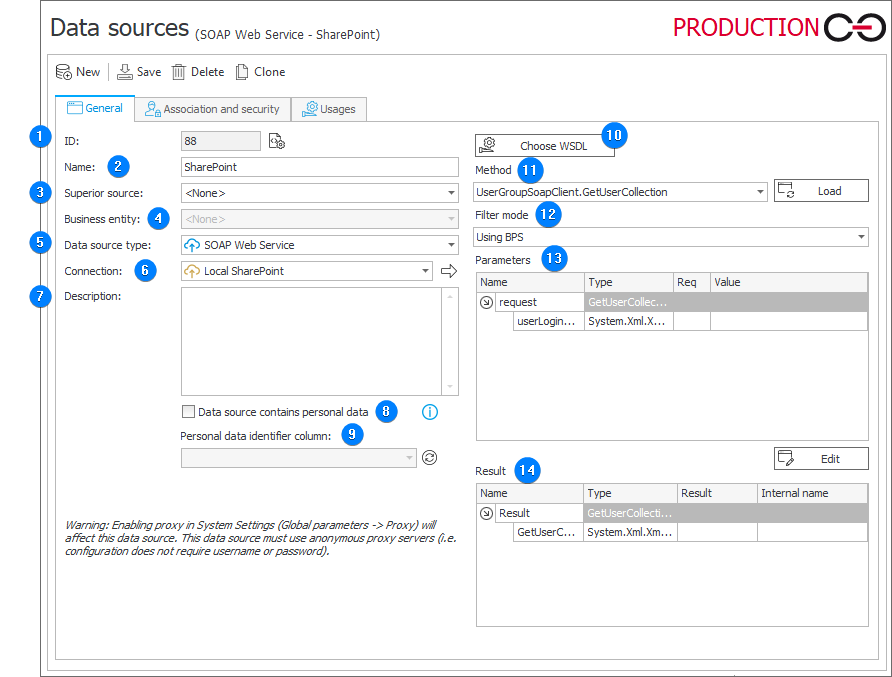SOAP Web Service
The feature enables you to execute any web service method, and use the returned values as a data source within the WEBCON BPS platform.
In the data source configuration, it is possible to load all web service method definitions from a WSDL file available either online or as a local file. It is possible to provide a specific method and the parameters with which it is invoked, as well as specify which of the available data collections is to be used in the data source.
The parameters for invoking a web service include: constant values, values obtained via query to the database, or values located in form fields of a workflow (can be referenced using the tag tree). Simple forms of data like strings or integers, as well as complex libraries of elements, are both supported.
By supporting most web services and providing two different modes of filtering, it is possible to handle most integration scenarios between BPS and external systems using only configuration options available in WEBCON BPS Designer Studio – without the need for implementing SDK data sources.

1. ID
The data source identifier (if the value is smaller than 0, the source has not been saved in the database yet).
2. Name
Name of the data source entered by the user.
3. Superior source
Each data source can contain subordinate sources which are related to a company within the system. If a superior source is referenced from a workflow element which belongs to a specific company, and that company has a subordinate source associated with it, the query will reference this subordinate source instead. If a superior source has been defined for the source, you must enter the name of the company for which it is defined.
4. Business entity
A business entity to which the defined source belongs. If the source has a defined business entity, entering the superior source is required.
5. Data source type
The type of the current data source. The field specifies the location from which data is retrieved.
6. Connection
The field is intended for defining authorization to access the database.
7. Description
Description of the data source defined by the user.
8. Data source contains personal data
The option designates the current Data source as a source of personal data for other processes. A relation between the Personal data dictionary and a process which uses such a dictionary as a source of data, requires additional configuration in every form field which is marked as containing personal data. Once configured, such a relationship allows the system to trace from which instance of a Personal data dictionary the form field obtained its value. Thanks to this, actions that delete or modify (anonymize) personal data are able to locate all the places that obtained data from a specific Personal data dictionary instance.
When a Data source is designated as a Personal data dictionary, it is required to specify a column in the data source which is to be used as the personal unique identifier. It is recommended that this column contains unique, numerical database identifiers.
9. Personal data identifier column
The field allows you to specify a unique identifier in the form of a database column.
10. Choose WSDL
Specifies the path to the WSDL file describing the web service.
The link can direct either to a network location or local file on the hard drive.
To select a WSDL file from a local disk, click Choose WSDL and then From disk, then specify the path to the file.
Provide the Authentication type (Anonymous, NTLM, Basic) – for the Basic option, also provide a username and password.
11. Method
The field allows you to choose a function of the specified web service that carries out an action (i.e. returns a collection of data).
12. Filter mode
Filtering according to the phrase (typed or selected with a picker) can be carried out in two ways:
- Using web service – allows the invoked phrase to be transferred as a parameter. Therefore, the whole logic of the search is kept on the side of the web service;
- Using BPS – all data returned by the web service can to be narrowed down to only that searched for by the user. There is no need to implement a filtering system within the web service.
13. Parameters
The field specifies where the web service obtains data for its calculations and processing.
14. Result
A list of data made available by the web service. Selecting the checkbox in the Result column causes all elements from a given collection to be available in the locations where the web service is used as a data source.
The display name of each element can be modified in the Internal name column.